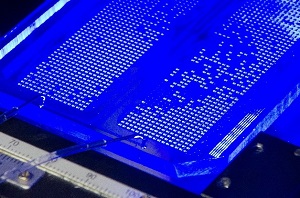Technology Profile

Quantitative BioSciences, Inc. , has developed a customizable sensor to continuously monitor water for arsenic, mercury, and cadmium, among other contaminants. A Business Innovation Research Grant from the NIEHS Superfund Research Program supported early work on the device.
The sensor employs a quarter-sized cartridge that can house many different bacterial strains, each engineered to fluoresce when it detects a specific contaminant. A machine learning platform, embedded in the device, translates those light signals into concentrations. Once deployed, the sensors can collect an ongoing stream of data on multiple contaminants simultaneously for at least a month, after which cartridges are easily replaced.
| Technology | A customizable sensor for continuously monitoring water for contaminants. |
|---|---|
| Innovation | The sensor employs engineered bacterial strains designed to fluoresce in response to contaminants of interest in water. Machine learning translates those signals into concentrations. Once deployed, the sensor collects a continuous stream of data on many contaminants simultaneously, without intervention, for 30 days. |
| Contaminant and Media | Arsenic, cadmium, iron, mercury, lead, manganese, copper, zinc, uranium, nitrate, nitrite, ammonium, and phosphate |
| Technology Readiness Level | 7 |
| Principal Investigator | Scott Cookson, Ph.D. |
| Institution | Quantitative BioSciences, Inc. |
| Grant Number | R43ES028993 |
to Top



